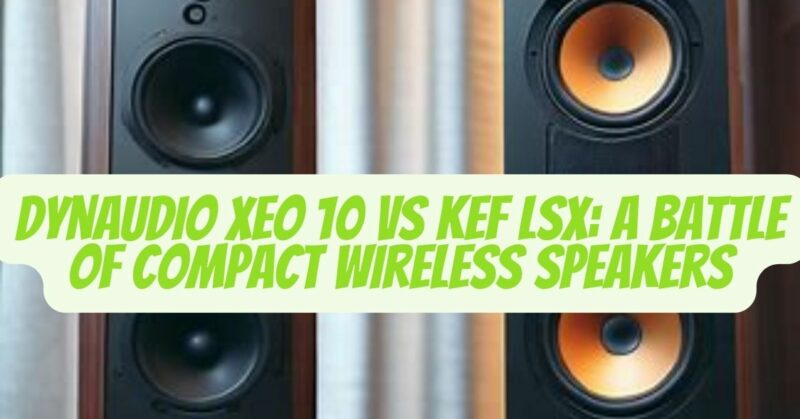Compact wireless speakers have become increasingly popular due to their convenience, minimalist design, and high-quality sound reproduction. Among the top contenders in this market segment are the Dynaudio Xeo 10 and the KEF LSX. Both speakers offer impressive features and audio performance, making it difficult for consumers to choose between them. In this article, we will compare and contrast the Dynaudio Xeo 10 and the KEF LSX to help you make an informed decision.
Design and Build Quality
When it comes to design, both the Dynaudio Xeo 10 and the KEF LSX are aesthetically pleasing, but they have distinct styles. The Xeo 10 boasts a sleek and minimalist look with a refined cabinet design and high-quality finishes. On the other hand, the LSX features a more contemporary design, with rounded edges and a wide range of vibrant color options. Both speakers are compact, making them suitable for various room sizes.
In terms of build quality, both models are well-constructed and feel solid. The Xeo 10 features a rigid cabinet design with a non-resonant baffle, ensuring minimal vibration and improved audio performance. The LSX, on the other hand, utilizes KEF’s Uni-Q driver technology, which places the tweeter concentrically within the midrange driver, resulting in a more focused sound dispersion.
Audio Performance
The audio performance is undoubtedly a crucial factor when comparing speakers. The Dynaudio Xeo 10 and the KEF LSX deliver exceptional sound quality, but with some noticeable differences.
The Xeo 10 offers a warm and detailed sound signature, with a well-defined midrange and excellent bass response. It boasts a 65-watt amplifier for each driver, resulting in powerful and dynamic audio reproduction. The Xeo 10’s frequency response is impressive, covering a wide range of 40Hz to 24kHz, ensuring that no detail is lost in the music.
The KEF LSX, on the other hand, produces a more balanced sound signature with a slightly brighter treble and tight bass response. With a total of 200 watts of amplification, the LSX offers a higher power output compared to the Xeo 10. Its Uni-Q driver technology enables a more immersive and expansive soundstage, creating a sense of depth and accuracy in the audio reproduction.
Connectivity and Features
Both the Dynaudio Xeo 10 and the KEF LSX excel in terms of connectivity options and features. They both support wireless streaming via Bluetooth and Wi-Fi, allowing you to enjoy music from various sources. Additionally, they offer multi-room capabilities, allowing you to synchronize multiple speakers in different rooms.
The Xeo 10 features Dynaudio’s own wireless transmission technology, which ensures a stable and interference-free connection. It also provides digital and analog inputs, including optical and RCA inputs, giving you flexibility in connecting different audio sources.
The KEF LSX supports AirPlay 2, Spotify Connect, and Tidal, allowing you to stream music directly from compatible devices. It also includes an HDMI ARC port, making it suitable for TV audio enhancement. Furthermore, the LSX has a dedicated app that provides intuitive control and customization options.
Price and Value
When it comes to pricing, the Dynaudio Xeo 10 and the KEF LSX are both premium wireless speakers, and their price reflects their quality and features. The Xeo 10 tends to be slightly more expensive than the LSX, making it a better option for audiophiles seeking exceptional sound reproduction.
However, the KEF LSX offers a compelling value proposition with its powerful performance, versatile connectivity options, and extensive feature set. It provides a balanced sound signature that can cater to a wide range of music genres and listening preferences.
Conclusion
In the battle between the Dynaudio Xeo 10 and the KEF LSX, it is evident that both speakers offer outstanding audio performance, sleek design, and versatile connectivity options. The choice between the two ultimately depends on your personal preferences and priorities.
If you prioritize a warm and detailed sound signature with excellent bass response, the Dynaudio Xeo 10 is an excellent choice. Its precise imaging and powerful amplification make it ideal for audiophiles who want to immerse themselves in their favorite music.
On the other hand, if you prefer a balanced sound signature with a wider soundstage and greater power output, the KEF LSX should be your consideration. Its Uni-Q driver technology and extensive connectivity options, including AirPlay 2 and HDMI ARC, make it a versatile speaker for both music and TV audio.
Furthermore, the KEF LSX provides a compelling value proposition, offering a range of features and connectivity options at a slightly lower price point compared to the Dynaudio Xeo 10.
Ultimately, the decision between the Dynaudio Xeo 10 and the KEF LSX comes down to personal preference, room size, and budget. We recommend listening to both speakers in person if possible to experience their unique sound signatures and determine which one resonates with you the most.
No matter which speaker you choose, both the Dynaudio Xeo 10 and the KEF LSX represent top-notch options in the compact wireless speaker market, delivering impressive audio performance and a premium listening experience.


